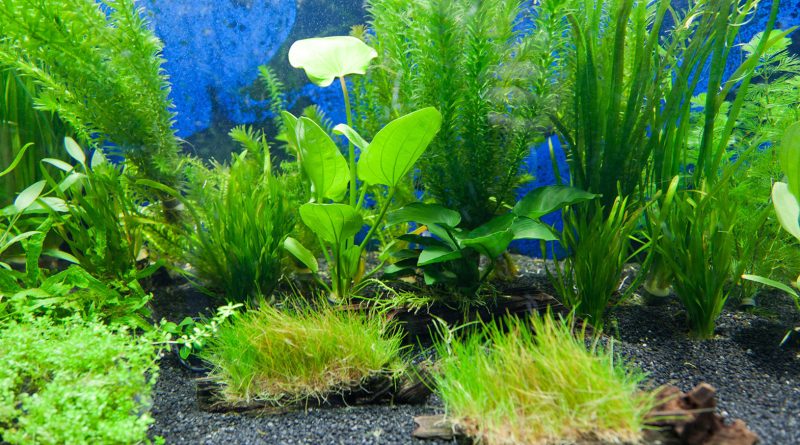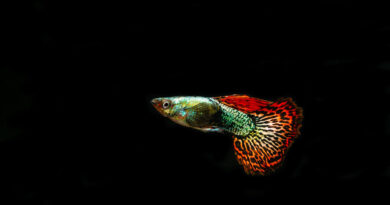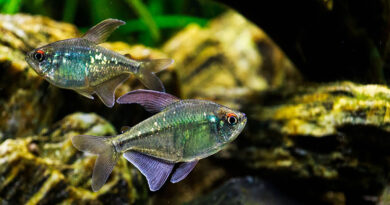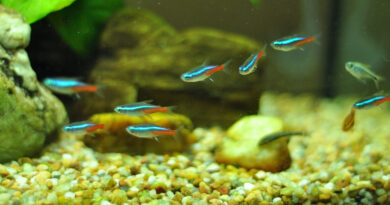How to setup a low tech beginner planted aquarium
Introduction
This article is a guide for those who are interested to set up their first beginner planted aquarium. Creating a serene and captivating underwater oasis with a low-tech planted aquarium is a delightful experience for both beginners and seasoned hobbyists.
A planted fish tank not only adds natural beauty to your living space but also provides a healthier environment for your aquatic pets. In this comprehensive guide, we will walk you through the step-by-step process of setting up a low-tech planted freshwater aquarium without the need for CO2 injection.
Embrace the tranquility of nature as we explore the world of low-tech aquarium plants and create a thriving aquatic ecosystem right in your home. This post will give you a clear answer to one of the most common questions in beginner planted aquariums, how to set up a planted aquarium?
Understanding the Need for a Planted Aquarium
Before delving into the setup process, it’s essential to understand the numerous benefits of having a beginner planted aquarium. As we always think, having a planted fish tank is not just a hobby, it’s an art that describes your creativity.
Becoming a produce owner of a planted freshwater aquarium always provides you joy and happiness. but it’s not limited to that, a planted fish tank offers the following advantages
1. Natural Filtration by planted aquariums
Aquatic plants act as natural filters, absorbing harmful ammonia and nitrates, which are by-products of fish waste. This biological filtration aids in maintaining water quality and ensures a healthy habitat for your fish.
By having a diverse selection of low-tech aquarium plants, you create a balanced ecosystem where the plants and fish work together in harmony. The plants take in nutrients from the water, effectively reducing the presence of harmful substances.
This natural filtration process not only ensures a healthier environment for your fish but also reduces the frequency of water changes required in the aquarium.
2. Oxygenation
Through photosynthesis, aquatic plants release oxygen into the water, supporting the respiration of your fish and other aquarium inhabitants.
In a low-tech planted aquarium, oxygenation is essential for the well-being of your fish. Adequate oxygen levels support their respiration and overall health. Additionally, oxygen-rich water encourages active and vibrant behavior in fish, as they have the necessary resources to thrive.
3. Stress Reduction
Studies have shown that observing beginner-planted aquariums can reduce stress and anxiety, making a planted aquarium a soothing addition to any environment.
Research has demonstrated that observing aquariums, especially those with lush greenery and active fish, can have therapeutic effects on individuals. The calming and soothing effect of watching fish glide gracefully through the water, combined with the gentle sway of plants, can reduce stress and anxiety levels.
Planted aquariums are often used in medical settings, waiting rooms, and offices to create a sense of relaxation and tranquility. The mesmerizing underwater world provides a momentary escape from the hectic pace of everyday life, allowing individuals to recharge and find a sense of peace in the presence of nature.
4. Aquatic Biodiversity
A well-planted aquarium provides a diverse environment for fish and other organisms, fostering a harmonious ecosystem.
A low-tech planted aquarium offers a unique opportunity to create a microcosm of nature within the confines of a glass tank. The presence of live plants provides a rich and diverse habitat that closely mimics natural aquatic environments.
This diversity attracts a wide range of aquatic organisms, such as different species of fish, shrimp, snails, and microorganisms, forming a balanced and harmonious ecosystem.
5. Aesthetics
The greenery look, and graceful swaying of plants add a touch of tranquility and elegance to your living space. Beyond the functional benefits, a low-tech planted aquarium offers a feast for the eyes. As the plants sway gently with the water movement, they add a sense of tranquility and life to your living space.
Aquascaping, the art of arranging plants, rocks, and other elements in the aquarium, allows you to express your creativity and design a captivating underwater scene. Whether you prefer a densely planted jungle or a minimalist layout, the beauty of a well-maintained planted fish tank never fails to captivate and enchant observers.
Selecting the Perfect Plants for Your Low-Tech Setup
Choosing the right plants is a crucial step in setting up a successful low-tech planted aquarium. Since you won’t be using CO2 injection and high-intensity lighting, it’s essential to opt for hardy and low-maintenance plant species that can thrive in such conditions. Consider the following options.
Hardiness: Look for plants that are known for their hardiness and ability to adapt to varying water conditions. Hardy plants are more forgiving and can recover quickly from minor fluctuations in water parameters.
Lighting Requirements: Low-tech setups typically use moderate to low-intensity lighting. Choose plants that can grow and thrive under such conditions without the need for additional CO2 supplementation.
Growth Rate: Consider the growth rate of the plants you select. Some plants grow rapidly and might require more frequent pruning to prevent them from overshadowing other plants in the aquarium.
Size: Be mindful of the ultimate size of the plants when fully grown. You don’t want to end up with an overcrowded aquarium, so choose plants that fit well within the dimensions of your tank.
Compatibility: Ensure that the selected plants are compatible with the fish species you intend to keep. Some fish may nibble on certain plant species, while others may prefer specific hiding spots provided by particular plants.
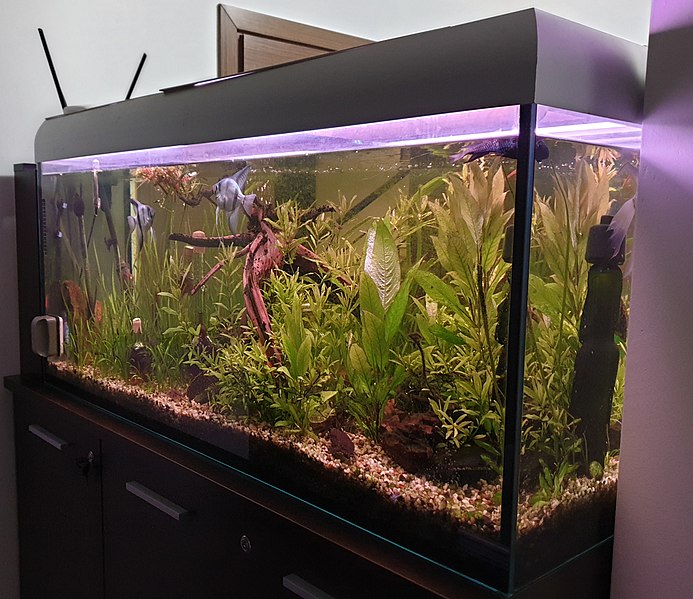
After you consider these factors for your beginner planted aquarium, the next step is to select which types of plants need to be added to the newly build planted tank.
This is also the most important part to consider when setting up a beginner planted aquarium. You can add several different varieties of popular low-tech aquarium plants to your planted aquarium since it’s going to be a beginner planted aquarium at this stage.
Here are some popular low-tech aquarium plants to consider for your setup.
Anubias aquarium plant
Anubias plant is a hardy aquarium plant that succeeds in low to moderate light conditions. It can be attached to driftwood or rocks, making it an excellent choice for planted aquariums.
Anubias is a low-tech aquarium plant that has captured the hearts of both experienced aquarists and beginners. Its adaptability, low-maintenance nature, and stunning appearance make it an ideal choice for low-tech planted aquariums, especially for those new to the world of aquatic gardening.
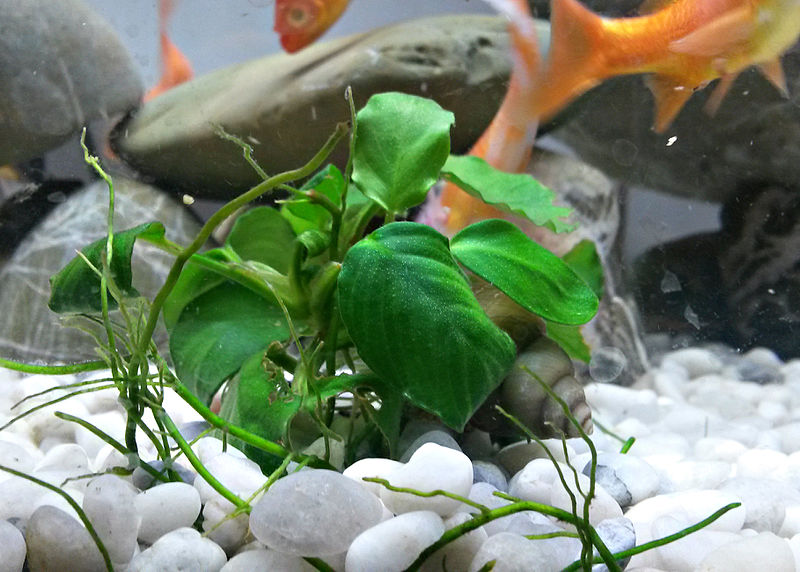
There is a number of specialties we can talk about in this plant which makes it a low-tech and best choice for your beginner planted aquarium. These are the few consideration that makes this plant for your planted aquarium.
Hardy and Resilient: One of the key reasons Anubias is perfect for beginners is its hardiness and resilience. It can tolerate a wide range of water parameters, including temperature, pH, and water hardness. This adaptability allows it to thrive even in less-than-ideal conditions, making it forgiving for those who are still learning to manage their aquarium’s water parameters.
Low Light Requirements: In low-tech planted aquariums, providing high-intensity lighting can be challenging and may lead to algae problems. Anubias, however, is well-suited for low-light conditions. It can thrive under moderate to low-intensity lighting, which means you don’t need to invest in expensive lighting systems. Standard aquarium LED lights or fluorescent bulbs are sufficient for its growth.
No CO2 Injection Required: High-tech planted aquariums often involve CO2 injection to support the rapid growth of plants. However, in low-tech setups, CO2 injection is unnecessary, as Anubias can thrive without it. This not only simplifies the setup process for beginners but also reduces the cost and complexity of maintaining the aquarium.
Propagation Made Easy: As your Anubias plant grows, you can easily propagate it to create more lush greenery in your aquarium. By dividing the rhizome into smaller sections, each with a couple of leaves and roots, you can plant new Anubias plants on other hardscape elements. This simple propagation method allows you to expand your planted tank without much effort.
Java Fern aquarium plant
This plant is another popular aquarium plant in freshwater-planted aquariums. Java Fern adds a beautiful greenery look to your aquarium.
Java Fern (Microsorum pteropus) is a perfect low-tech aquarium plant, and it’s a perfect choice for beginner planted aquariums.
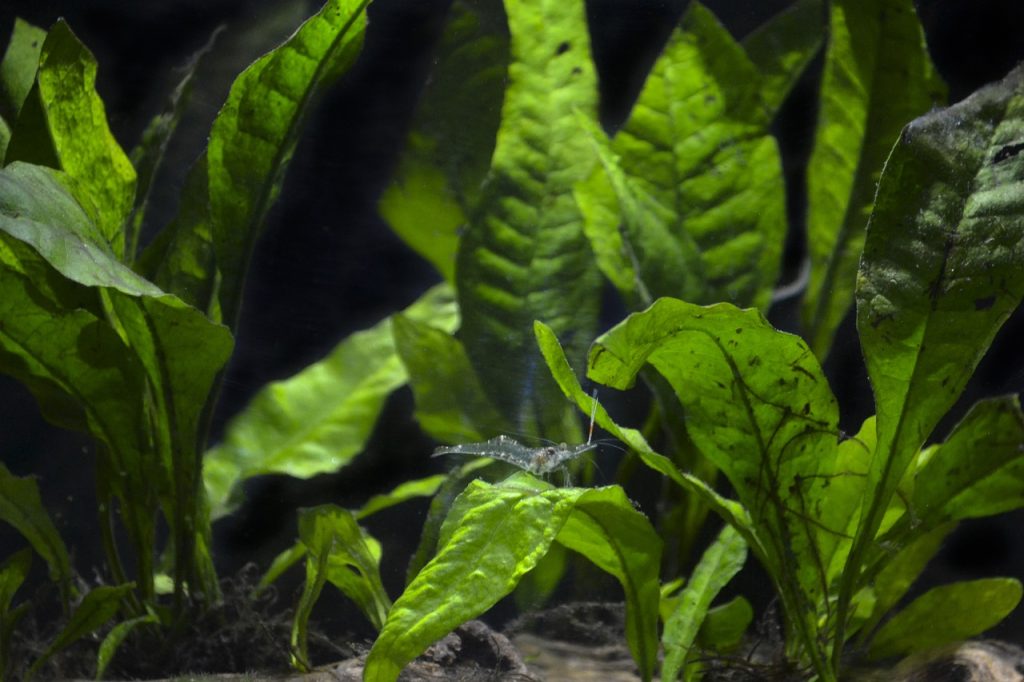
This aquarium plant also has some key features which make it one of the best beginner planted aquariums as a low-tech plant.
Hardy and Low Maintenance: Java Fern is renowned for its remarkable ability to thrive in a wide range of water conditions. It can tolerate varying temperatures, pH levels, and water hardness, making it a hardy and low-maintenance plant. For beginners, this adaptability is a blessing, as it provides a forgiving plant to work with while learning the basics of aquarium care.
No CO2 Injection Needed: Java Fern can thrive without the need for CO2 supplementation. It obtains the necessary carbon from the aquarium water and naturally adapts to low CO2 environments, making it a hassle-free choice for beginners.
Slow Growth Rate: Java Fern has a moderate to slow growth rate, which is beneficial for beginners. Its manageable growth means you won’t need to prune or trim it frequently. This allows you to sit back and enjoy the beauty of the plant without constant maintenance.
Fish Compatibility: Java Fern is well-tolerated by a wide variety of fish and invertebrates. Its sturdy and leathery leaves are less appealing to herbivorous fish, reducing the chances of them nibbling on the plant. Additionally, Java Fern provides hiding spots and shelter for small fish and shrimp, making it a valuable addition to community tanks.
Cryptocoryne aquarium plant
This plant comes in various colors and sizes, making it ideal for creating visual diversity. It is also relatively easy to care for and can tolerate lower light levels.
Cryptocoryne, also known as “Crypts,” is a highly favored aquarium plant among beginners due to its suitability for low-tech planted aquariums. This versatile and hardy plant offers a range of species and varieties, each bringing its unique charm to the aquatic landscape.
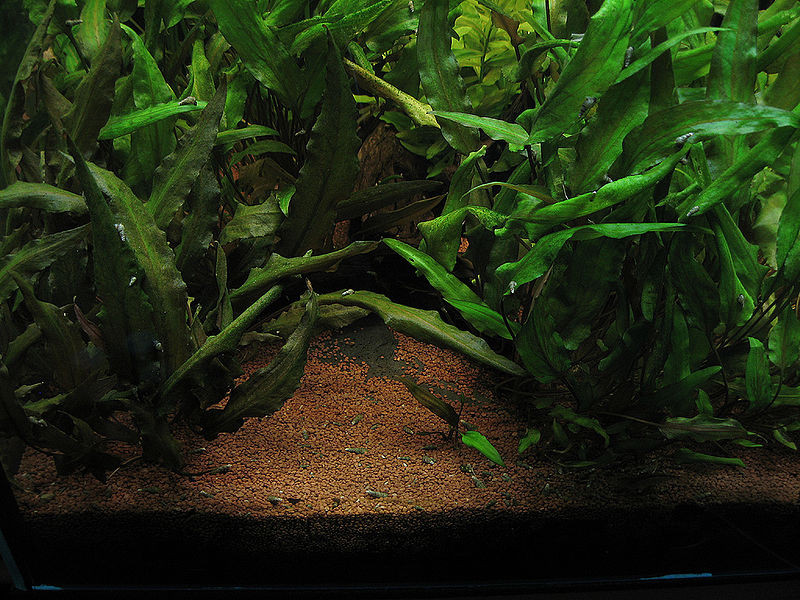
Let’s talk about the key features and specialties which make this a perfect choice for your beginner planted aquarium.
Easy Care and Low Light Tolerance: Cryptocoryne thrives in low light conditions, making it ideal for low-tech setups. It doesn’t demand intense lighting, and standard aquarium LED lights or fluorescent bulbs are sufficient for its growth. This low light tolerance eases the setup process for beginners, eliminating the need for complex lighting systems.
Slow Growth and Manageable in Size: As a slow-growing plant, Cryptocoryne does not require frequent pruning or trimming, reducing maintenance demands for beginners. Its moderate size makes it an excellent choice for foreground or midground placement, complementing other plants in the aquarium.
Propagation: Cryptocoryne propagates naturally by sending out runners, which produce new plantlets. These plantlets can be left to grow or separated to create new plants. This effortless propagation method allows beginners to expand their Cryptocoryne collection without much effort.
Versatility in Water Parameters: Cryptocoryne is remarkably adaptable to a variety of water parameters, including temperature, pH, and water hardness. It can thrive in a broad range of conditions, providing beginners with flexibility in maintaining their aquarium environment.
Amazon Sword aquarium plant
Known for its striking appearance, the Amazon Sword is a popular choice for mid-ground and background planting. It requires minimal care and can grow quite large.
The Amazon Sword (Echinodorus amazonicus) is a popular and striking aquatic plant that has won the hearts of many aquarium enthusiasts, especially beginners. Its robust and lush appearance, coupled with its ease of care, makes it an excellent choice for low-tech planted aquariums.
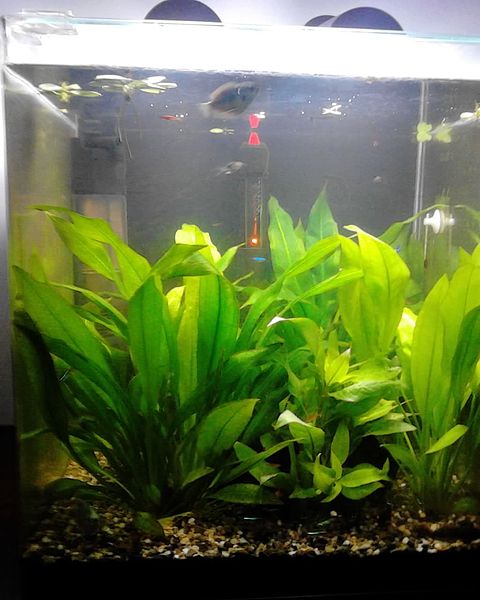
This plant also has its own feature to make it a good choice for beginner planted aquariums. Therese are feature of of Amazon Sword plants to consider as a low-tech beginner aquarium plant.
Low Light Tolerance: The Amazon Sword is well-adapted to low-light conditions, making it an ideal choice for low-tech setups. It thrives under standard aquarium LED lights or fluorescent bulbs, eliminating the need for expensive and complex lighting systems. Its ability to flourish in lower light intensities simplifies the setup process for beginners.
Minimal CO2 Requirements: Unlike high-tech planted aquariums that demand CO2 injection, the Amazon Sword can thrive without additional CO2 supplementation. It efficiently utilizes carbon from the aquarium water, making it a low-maintenance choice for those who prefer a simpler setup.
Hardy and Resilient: The Amazon Sword is known for its hardiness and resilience. It can adapt to various water parameters, including temperature, pH, and water hardness, making it an undemanding plant for beginners. Its ability to tolerate fluctuating conditions ensures a forgiving environment for newcomers to the hobby.
Versatile Placement: The Amazon Sword can be placed directly in the substrate, where its robust root system quickly anchors it in place. It can be used as a stunning centerpiece in the background or as a focal point in the midground, adding depth and visual interest to the aquarium.
Vallisneria aquarium plant
Perfect for background planting, Vallisneria adds vertical interest with its long, ribbon-like leaves. This plant can grow in low to moderate light conditions.
Vallisneria, commonly known as “Vallis” or “Jungle Val,” is a popular and beginner-friendly aquatic plant that has become a staple in many planted aquariums. Its attractive appearance, low maintenance requirements, and adaptability to various conditions make it an excellent choice for low-tech beginner planted aquarium setups.
There are various reasons to consider the Valliseneria plant to become a topic choice for an aquarium-planted tank. These are some of the facts to prove it.
Rapid Growth and Oxygenation: Vallisneria is known for its fast growth rate, making it an excellent choice for beginners seeking to establish a lush and vibrant aquatic environment quickly. As it grows, Vallisneria actively contributes to oxygenating the water through its photosynthesis process, promoting a healthier habitat for fish and other aquarium inhabitants.
Low Light Tolerance: One of the standout features of Vallisneria is its ability to thrive in low light conditions. It can flourish under standard aquarium LED lights or fluorescent bulbs, eliminating the need for complex lighting systems. This makes it a budget-friendly and hassle-free choice for beginners.
Water Quality Enhancement: Vallisneria is an effective nutrient absorber, helping to maintain water quality by consuming excess nutrients like nitrates and phosphates. This natural filtration aids in reducing algae growth and maintaining a well-balanced ecosystem.
Aesthetic Appeal: With its long, slender leaves and graceful appearance, Vallisneria adds a touch of elegance and movement to the aquarium. Its swaying motion in the water creates a captivating and natural effect, enhancing the overall aesthetics of the tank.
Before purchasing your plants, inspect them for any signs of pests or diseases. Choose vibrant, healthy-looking specimens, and if possible, purchase from a reputable source or nursery.
To create an aesthetically pleasing aquascape, consider combining different plant shapes, sizes, and colors. By using a variety of low-tech aquarium plants, you can create a natural and visually appealing underwater landscape that is not only beautiful but also provides a nurturing environment for your fish and other aquatic inhabitants.
Essential Equipment for a Low-Tech Beginner Planted Aquarium
Aquarium planted tank equipment AKA “aquasacping” equipment is an essential tool for setup your first beginner planted aquarium.
This section will guide you through some of the most important must-to-have aquarium types of equipment for your first planted fish tank.
To set up a thriving low-tech planted aquarium, you’ll need several essential pieces of equipment. These tools and devices play a crucial role in providing a suitable environment for your aquatic plants and fish. Let’s discuss more about them.
1. Aquarium Tank: The first and most fundamental piece of equipment is the aquarium tank itself. Choose a tank size that suits the space you have available and the number and size of fish you plan to keep. For a low-tech setup, a tank with a capacity of at least 20 gallons is recommended, as larger volumes of water tend to be more stable in terms of temperature and water chemistry.
2. Fish tank Substrate: A nutrient-rich substrate is vital for the health and growth of your low-tech aquarium plants. There are various types of substrates available, including aquarium soil and gravel specifically formulated for planted aquariums. These substrates provide essential nutrients to the plant roots and support their development.
3. Aquarium Decorations: Enhance the aesthetics of your low-tech planted aquarium with natural-looking decorations. Rocks, driftwood, and ornaments can create a visually appealing aquascape and provide hiding spots for your fish. Live plants and hardscape elements work together to form a harmonious underwater landscape.
4. Aquarium Heater: Unless you plan to keep cold-water fish that thrive in lower temperatures, a heater is necessary to maintain a stable and suitable water temperature for your tropical fish and plants. Most tropical fish prefer a water temperature in the range of 75°F to 82°F (24°C to 28°C). Invest in a reliable adjustable heater to control the water temperature accurately.
5. Aquarium Lighting: Proper lighting is essential for the photosynthesis process in plants. For low-tech planted aquariums, select low to moderate-intensity LED lights. High-intensity lighting is not necessary and may lead to algae problems. Look for lights with a color temperature in the range of 6500K to 10000K, as this spectrum closely resembles natural daylight and promotes healthy plant growth.
6. Water Filtration: Filtration is vital for maintaining water quality in your low-tech planted aquarium. A good-quality filter will remove debris, uneaten food, and other organic waste, keeping the water clear and preventing the buildup of harmful substances. A hang-on-back (HOB) or canister filter is a popular choice for planted aquariums.
7. Aquarium Test Kit: Monitoring water parameters is essential for ensuring a healthy environment in your planted aquarium. An aquarium test kit will allow you to measure parameters such as ammonia, nitrite, nitrate, pH, and others. Regular testing will help you spot any issues and take corrective measures promptly.
8. Algae Scraper/Magnet: Algae growth is normal in any aquarium, but it’s essential to keep it in check. An algae scraper or magnet can help you remove algae from the glass without disturbing your plants or stressing your fish. This tool will help you keep your beginner planted aquarium very visible and clean for the human eye.
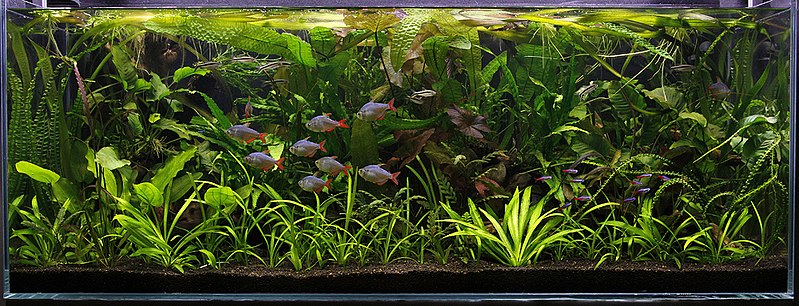
Besides this must-to-have freshwater equipment, the following equipment is good to have on your list as it will be helpful to have them when maintaining your beginner planted aquarium.
These tools may not be required for everyone, but having them in your hand when needed will always help in managing a beginner planted aquarium.
1. Aquarium Thermometer: Along with a heater, an aquarium thermometer is essential for monitoring water temperature. Opt for a reliable and accurate thermometer to ensure that your fish and plants are comfortable.
2. Fish Net: A fish net is a basic tool for safely catching and handling fish during tank maintenance or when introducing new inhabitants to your aquarium.
3. Aquarium Substrate cleaner: When the tank is with plants, you need to clean your aquarium substrate very carefully, There are essential tools you can use to clean up your freshwater planted aquarium substrates. These tools will help you to clean the substrate without harming your aquarium’s live plants.
4. Aquarium water change tubes: This tool is also better to have in the process of water changing in your freshwater planted aquarium. Water change tubes will help you take the water out of the tank carefully without messing up your live plants.
Before setting up your low-tech beginner planted aquarium, ensure that all the equipment is in good working condition. Additionally, do a dry run with the substrate, decorations, and equipment outside the tank to visualize your aquascape and make any necessary adjustments.
By investing in quality equipment and providing your plants and fish with a stable and nurturing environment, your low-tech planted aquarium will flourish and become a beautiful display of aquatic life in your home. Regular maintenance and attention to water quality will ensure the long-term success of your planted aquarium.
Step-by-Step Guide to Setting Up a Low-Tech Beginner Planted Aquarium
This might be the most awaited part of this article. Here I am going to give you an idea about the steps you should follow to set up your first planted fish tank.
Now you know what aquarium plants are the best for your beginner planted aquarium and what are the essential aquasacping tool you need to have.
The next step is to learn, how to set up your planted aquarium step by step. Now, let’s dive into the exciting process of setting up your low-tech planted aquarium.
1. Planning Your Aquascape: Before you begin, take some time to plan the layout of your low-tech planted aquarium. Consider the size and shape of your tank, the placement of hardscape elements (rocks, driftwood, etc.), and the arrangement of plants. Think about creating open swimming spaces for your fish and leaving room for plant growth. Having a clear vision of your aquascape will make the setup process more efficient.
2. Positioning the Hardscape: Now, position the rocks, driftwood, or other decorations in your desired locations within the tank. These hardscape elements will serve as anchor points for your low-tech aquarium plants. Arrange them carefully to create a natural-looking environment. Make sure the hardscape is stable and won’t topple over.
Placing rocks, driftwood, or other decorations in your desired locations will serve as anchor points for your low-tech aquarium plants.
3. Adding Water: This is something you need to do very patiently and carefully. Fill the aquarium with dechlorinated water, taking care not to disturb the substrate or hardscape elements. You can simply use your hand of a small cup with some holes for this better way. There are some other plants of options to do this properly as well. Take it as your new mini-research lol.
4. Planting Your Aquarium: Begin by planting the larger plants in the background and the smaller ones in the foreground. Gently remove the plants from their pots, trim any damaged roots, and insert them into the substrate. Press the substrate firmly around the roots to secure them in place.
Gently remove the plants from their pots, being careful not to damage the roots. Trim any damaged or excessively long roots. Create small holes in the substrate using your fingers or a planting tool and insert the plants into these holes. Press the substrate firmly around the roots to secure them in place.
As you plant, keep in mind the spacing between each plant to prevent overcrowding. Proper spacing allows your plants to grow and spread without competing for resources.
5. Cycling the Aquarium: Before adding fish, cycle the aquarium to establish a stable nitrogen cycle. This will promote the growth of beneficial bacteria that help break down fish waste.
To cycle the aquarium, you can use various methods, including adding ammonia or using a biological starter product. Regularly monitor water parameters during the cycling process to ensure the establishment of a healthy nitrogen cycle.
6. Introducing Fish: Once your low-tech planted aquarium has completed the cycling process, it’s time to introduce fish. Start with a small number of hardy and compatible fish species. Hardy fish, like some tetras or guppies, are more tolerant of water parameter fluctuations.
Be mindful of the fish’s social behavior and compatibility with other inhabitants. Avoid overstocking the aquarium, as it can lead to stress and water quality issues. Gradually introduce new fish over time, allowing the tank to adapt to the increased bioload.
7. Adjust if needed: After setting up your low-tech planted aquarium, spend time observing the behavior of your fish and the growth of your plants. Pay attention to water parameters, temperature, and any signs of distress in your fish or plant health.
Make adjustments as needed. For example, you may need to adjust the lighting duration, prune overgrown plants, or perform water changes to maintain optimal water quality. As your plants grow, you may also rearrange them to achieve a more balanced and appealing aquascape.
Caring for Your Low-Tech Beginner Planted Aquarium
Once you followed all the above steps to setting up your first beginner planted aquarium, now you have to learn about how to maintain it.
Planted fish tanks need to maintain more regularly than other normal freshwater aquariums to keep them healthy and attractive as planted aquariums. Also, this is one of the most important steps in aquafarming.
Maintaining a low-tech planted aquarium is relatively straightforward. Caring for your low-tech planted aquarium is essential to ensure the health and longevity of your plants and fish.
Although low-tech setups require less maintenance than high-tech ones, regular care is still necessary to keep the ecosystem balanced and flourishing. To make this short and sweet and make this more understandable, I have added the below points to get an idea about maintaining your first beginner planted aquarium.
1. Lighting Schedule: Set a consistent lighting schedule for your aquarium. Aim for 8-10 hours of light per day to mimic natural daylight. Use a timer to automate the lighting cycle, ensuring that your plants receive a consistent and appropriate amount of light each day. Too much or too little light can affect plant growth and encourage algae growth.
2. Pruning and Trimming: Trim overgrown or decaying plant leaves to encourage healthy growth and prevent nutrient imbalances. As your plants grow, they may require pruning and trimming to maintain their shape and prevent overcrowding. Remove any overgrown or decaying plant leaves using clean scissors or trimming tools. Pruning also helps to promote healthy growth and prevents nutrient imbalances.
3. Water Changes Perform regular partial water changes to maintain water quality and remove accumulated nitrates. For a low-tech planted aquarium, a water change of 20-30% every 1-2 weeks is generally sufficient. Use a siphon to vacuum debris from the substrate during water changes.
4. Monitor Water Parameters: Regularly test water parameters to ensure they remain within acceptable ranges. Monitor ammonia, nitrite, nitrate, pH, and other relevant parameters. Sudden changes in water parameters can be stressful for your fish and may affect plant health.
5. Algae Control: Monitor your aquarium for signs of algae growth. If necessary, manually remove algae or consider adding algae-eating fish like snails or certain species of fish.
Algae growth is common in all aquariums, but in a low-tech setup, it’s essential to manage it effectively. Keep a balance between lighting, nutrients, and plant growth to prevent excessive algae blooms. You can manually remove algae using an algae scraper or magnet. Introduce algae-eating fish, such as certain species of snails or small plecos, to help control algae growth naturally.
6. Address Plant Health Issues: Pay attention to any signs of plant health issues, such as yellowing leaves or stunted growth. Yellowing leaves may indicate nutrient deficiencies, while brown or transparent leaves could be a sign of nutrient excess or poor lighting. Adjust fertilization and lighting accordingly to address these issues.
7. Fertilization: While a low-tech setup relies on the nutrient-rich substrate, you may occasionally add liquid fertilizers designed for low-tech aquariums to supplement essential nutrients. In low-tech planted aquariums, plants primarily get nutrients from the substrate. However, depending on the plant species and fish load, you may occasionally need to supplement nutrients with liquid fertilizers. Choose fertilizers specifically designed for low-tech setups, as they contain essential nutrients without causing algae issues.
8. Maintain a Clean Environment: Regularly clean the glass, remove debris, and tidy up the aquarium surroundings. A clean and well-maintained environment enhances the beauty of your low-tech planted aquarium and contributes to the overall well-being of your aquatic ecosystem.
Following these 8 easy steps will help to get an idea about how to care for and maintain your first beginner planted aquarium. It’s not hard work to do when you have a clear understanding of each point.
Conclusion
Cheers!! now you know how to set up your first beginner planted aquarium. This article is a guide for any beginner who is looking to start their first planted aquarium.
As I explained in the beginning, Planted aquariums or aquascaping is not just a hobby it’s an art. Now you can master this art and be processional personal in aquasacping by getting the basic idea of fundamentals related to freshwater planted aquariums by reading this article.
With the right plant selection, essential equipment, and proper care, your planted fish tank will flourish, creating a harmonious and picturesque underwater ecosystem. Enjoy the tranquility and beauty of your aquarium as you witness the natural wonder of your plants and fish thriving in perfect harmony.
If you feel this really helpful, don’t forget to share this with friends. Also, if you need to ask anything additionally or need to add any more details you are welcome to use the comment section below.

